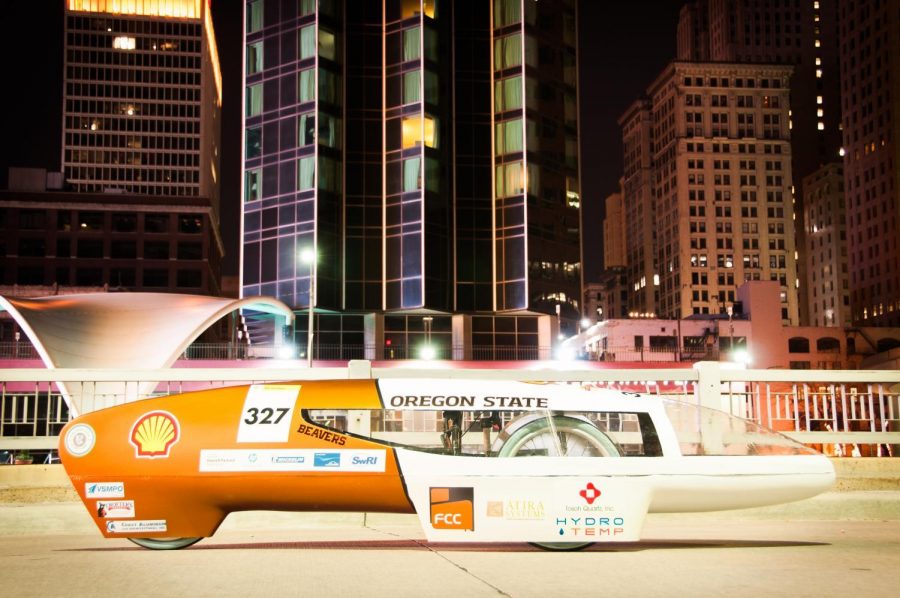Beaver Bolt Racing takes second
May 5, 2016
Last weekend, the Beaver Bolt Racing team took second place in the electric prototype category at the Shell Eco-Marathon, a fuel efficiency competition.
According to the Shell website, the Shell Eco-Marathon is a fuel efficiency competition at which teams make as many attempts as possible to travel the furthest on the equivalent of one liter of gasoline. The organizers calculate the efficiency of each vehicle from the results and name a winner from each category and fuel type.
According to Austin Sandifer, the business lead for Beaver Bolt Racing and driver of the car, the team competed in the prototype electric vehicle category, where one liter of gasoline was converted into electricity.
“We can mathematically calculate how many miles to the gallon it would have been,” Sandifer said. “The number we got was around 8,700 miles to the gallon equivalency.”
This Beaver Bolt Racing’s first year in the competition, according to Sandifer.
According to Sandifer, the team was able to achieve this fuel efficiency by having an efficient lightweight motor push a lightweight 99 pound car with minimal air resistance and tire friction.
“We can achieve really high numbers because electricity going through a brushless motor is a lot more efficient than gasoline exploding and pushing down a piston,” Sandifer said. “When gasoline explodes, a lot of the energy is wasted as heat. We don’t have that loss with electricity.”
According to Sandifer, the minimum driver weight for the competition was 111 pounds. For the competition his body weight was 111 pounds, which then totalled 113 pounds with his fire suit and helmet, after losing water weight.
“When we started to build this vehicle, they measured me up, like you would do for buying a suit and then they built the vehicle around how big I was, to make it as small as possible,” Sandifer said.
According to Sandifer, Beaver Bolt Racing decided to do this after noticing that it was the starting point of the more successful teams.
Laying flat on his back, Sandifer had to look over his toes to steer the vehicle. The steering design consisted of two wheels connected to each other and on an axle with a metal steering rod. The steering rod moved the car similar to how a tiller on a sailing ship moves the boat and only allows the driver to use one hand.
“It was a little difficult to drive,” Sandifer said. “You had to really hold it going straight, or else it would not drive in a straight line.”
At the race course, the team had three full tests. The tests were simulation runs in order for the team to see what they needed to fix and make adjustments to improve race performance.
“We pushed all of our team members very hard, to get those tests out, because we wanted to make sure that our car was not only drivable, but consistently drivable for the entire competition,” Sandifer said. “It wasn’t a really good simulation, we got only 2500 miles to the gallon. We almost quadrupled that at competition.”
Not all teams were as organized at competition, according to Sandifer. Some teams came with incomplete cars.
According to Sandifer, there were two kinds of teams in the competition. The first were well-funded organizations, like Beaver Bolt Racing, trying to break the world record in efficiency, and the other type of team, instead of shipping a complete car to competition, just shipped a box of materials. Only one of those teams succeeded.
Last year Chase Jones, the team lead, was disappointed by a bike building competition. The competition required teams to construct the most efficient bike possible. But according to Jones, the competition came down to which team had the most athletic biker. Jones wanted a competition more based around improving his engineering skills.
“It was a good environment. It was very non-competitive,” Jones said, talking about the competition. “No one really had private knowledge that they were holding on to. No one had their secret sauce.”
Jones chose the Shell competition, because it didn’t have as strict rules and gave a stipend for competitors.
“Me and Chase Jones are the two leaders of this idea from last year. He really wanted to do (the Shell competition) and we sat down together last summer (…) We decided we wanted to do it. We took summer classes and fundraised all throughout the summer to get enough money to do this competition,” Sandifer said. “Then through the fall we designed the car. Through the winter we built the car and then for the first half of spring we figured out how to actually get the car (sic) competeable and in Detroit at the same time, which was a lot of late nights.”
According to Jones everyone wanted to help one another learn and grow. Teams that had finished their cars would help other teams finish theirs. After Beaver Bolt Racing had finished their car, their electrical engineer wired up the cars of two other teams.
According to Sandifer the budget for the competition, including material donations, was around $20,000, about a fourth coming from OSU. Most of their donations were through materials, since companies were hesitant to give them cash. Any carbon fiber or titanium donated could be melted down and used for parts.
Even with the cash funding for the competition, OSU did not supply a place to build the vehicle. According to Jones, the vehicle was built off-campus at Atira Systems, which a parent of one of the team members owns. At OSU, they could build using one of the room, but had to put all the stuff back into a storage closet when they finished. Jones attributes this lack of space as a struggle the university itself has with the required lab space for all its classes. Due to the shortage of space, clubs are often unable to have the spaces on campus they need.
























































































































